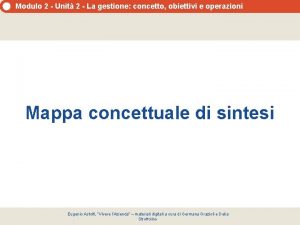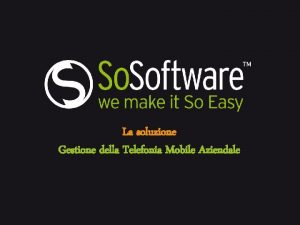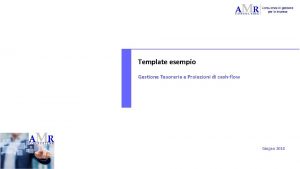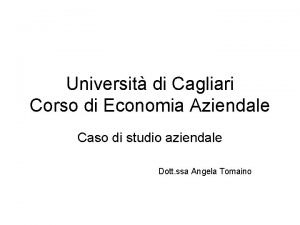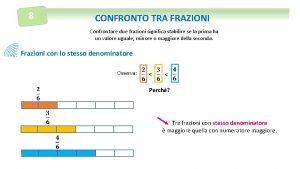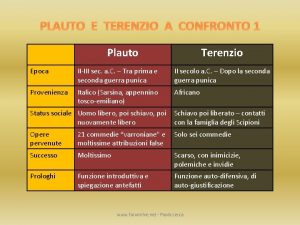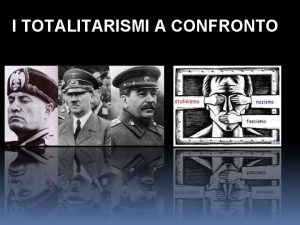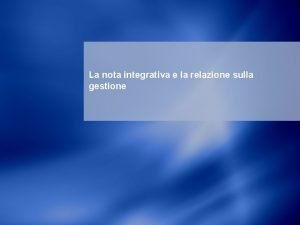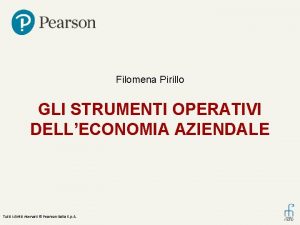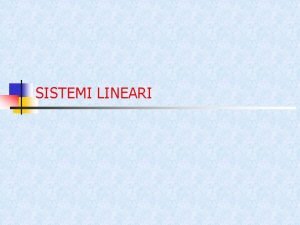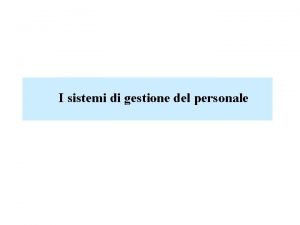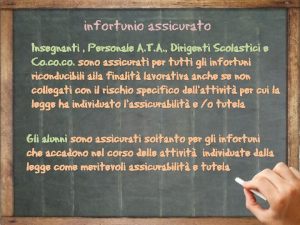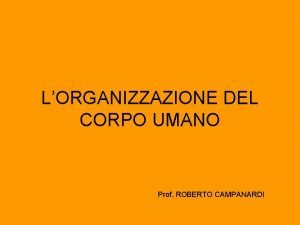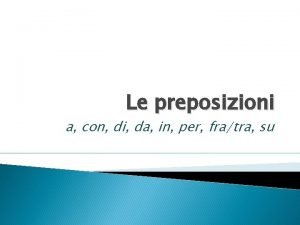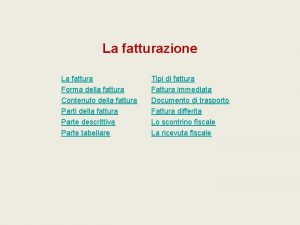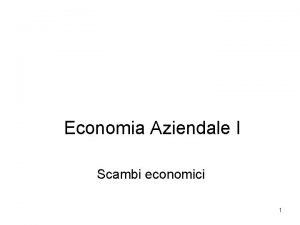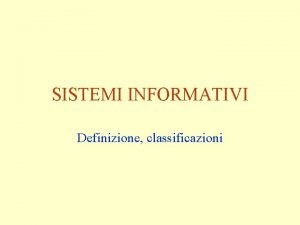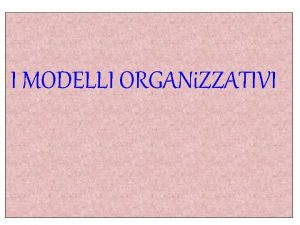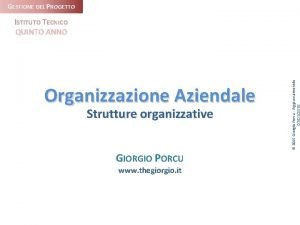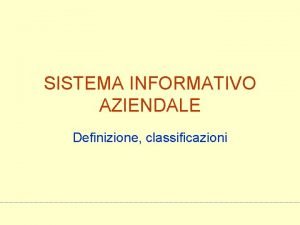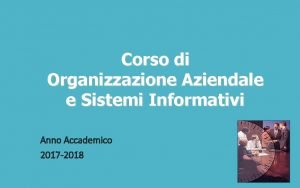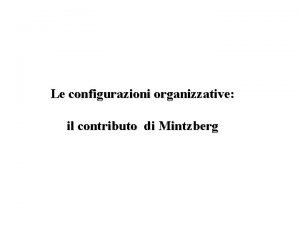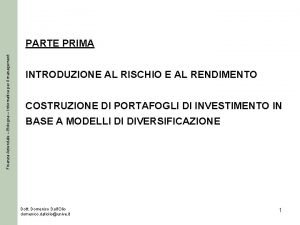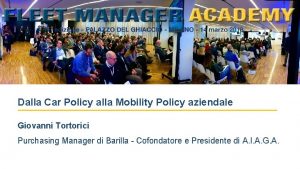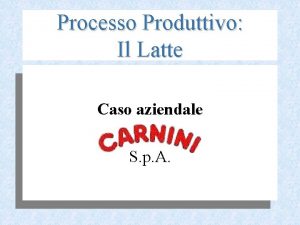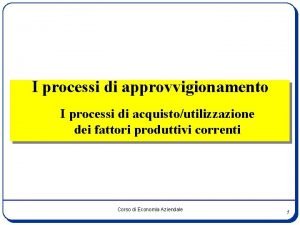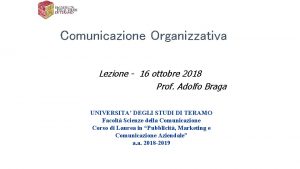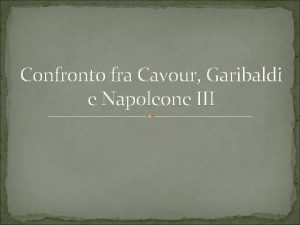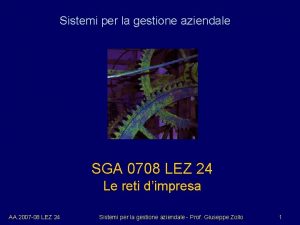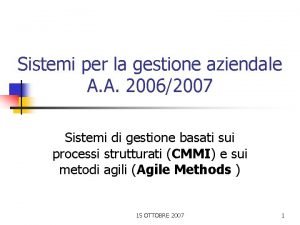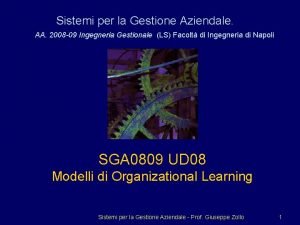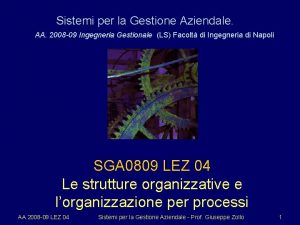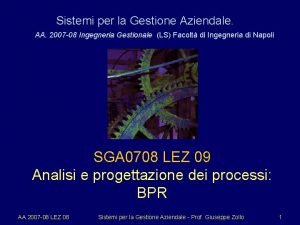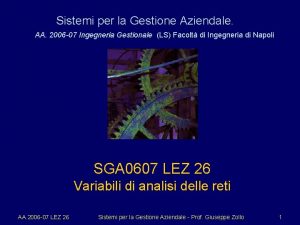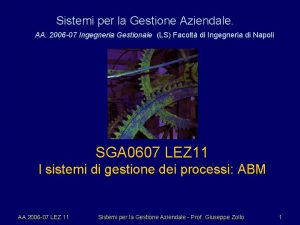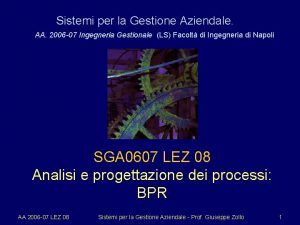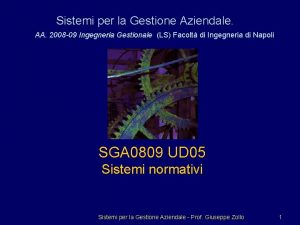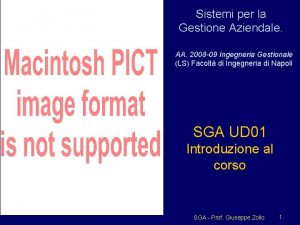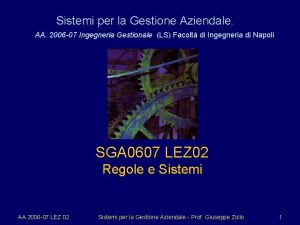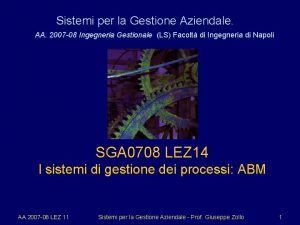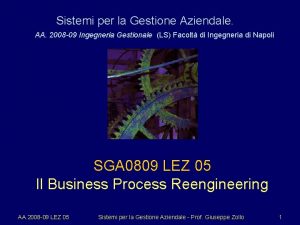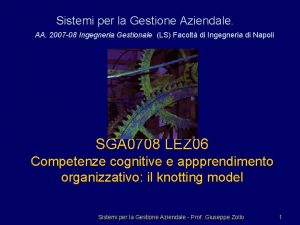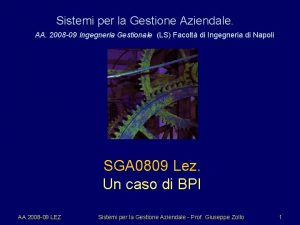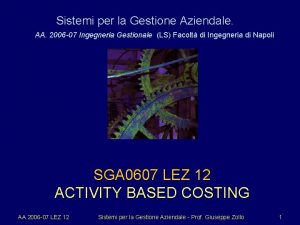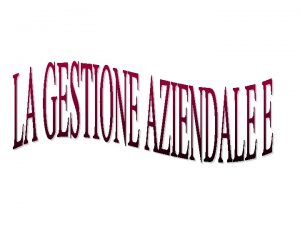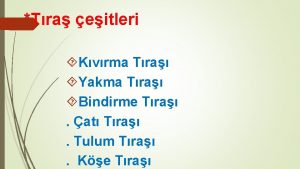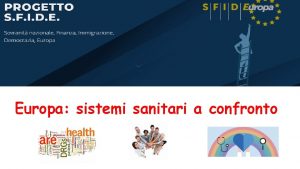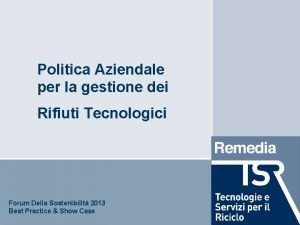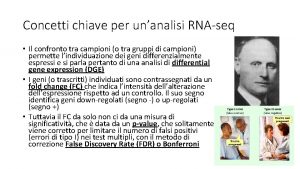Sistemi per la gestione aziendale Confronto tra Sistemi





































- Slides: 37

Sistemi per la gestione aziendale Confronto tra Sistemi cibernetici basati sui processi strutturati (CMMI) e Sistemi generativi basati sui metodi agili (Agile Methods ) 1 DICEMBRE 2008 1

Process Improvement in the Service Industry and Public Administration Agile Methods vs. CMMI Tratto dall’intervento al convegno del 19 GIUGNO 2007 1 DICEMBRE 2008 2

Agile Methods vs. CMMI presentation contents reflect the opinions of the authors and does not necessarily reflect a position of the AICQ-M or the PMI_SIC. 1 DICEMBRE 2008 3

Joint (AICQ–M &PMI-SIC ) Working Group for Agile Software Project Management – PMO 2 Ing. Valerio Teta Member of the AICQ Software Committee Coordinator of AICQ-M activities about ICT v. teta@unina. it 1 DICEMBRE 2008 4

Joint Working Group n n n The Working Group is formed on December 2006 by 10 software practitioners members of two organizations: AICQ-M & PMI_SIC. AICQ-M: Associazione Italiana Cultura Qualità - Meridionale (Italian Association for Quality Culture – Southern Italy). PMI_SIC: Project Management Institute Southern Italy Chapter. 1 DICEMBRE 2008 5

1 DICEMBRE 2008 6

1 DICEMBRE 2008 7

Joint Working Group scope n n Adopt Agile Manifesto. Promote change in our daily work into the areas of interest (Software Engineering Process - Software Engineering Management -Technology Management). Apply new approach to small settings in the Southern Italy. Renew Project Management Office e Program Management Office roles into Agile Management – PMO 2 1 DICEMBRE 2008 8

The Agile Manifesto (values) Individuals and interactions over processes and tools Working software over comprehensive documentation Customer collaboration over contract negotiation Responding to change over following a plan n © 2001, Kent Beck, Mike Beedle, Arie van Bennekum, Alistair Cockburn, Ward Cunningham, Martin Fowler, James Grenning, Jim Highsmith, Andrew Hunt, Ron Jeffries, Jon Kern, Brian Marick, Robert C. Martin, Steve Mellor, Ken Schwaber, Jeff Sutherland, Dave Thomas 1 DICEMBRE 2008 9

The 9 members Paola Antonini Natalino Crisarà Marco Evangelista Paola Mosca Ciro Petrillo Francesca Rigosi Raffaele Sannino Filomena Sichenze Valerio Teta ntnpla@tiscali. it natalino. crisara@libero. it mevangel@libero. it paola. mosca@gmail. com ciro. petrillo@inwind. it francesca. rigosi@gmail. com lello. sannino@gmail. com milena. sichenze@gmail. com v. teta@unina. it 1 DICEMBRE 2008 10

Our program n n A cookbook on the role of the project / program office in the agile approach (December 2007) A workshop about agility (October 2007) 1 DICEMBRE 2008 11

Links http: //agilemanifesto. org/ http: //www. aicqsw. it/ http: //www. aicq-meridionale. it/home. Page. htm http: //www. pmi-sic. org/ 1 DICEMBRE 2008 12

PMO 2: Project & Program Management Office nella gestione agile di progetti SW Nuovi ruoli e nuovi contesti del PMO nell’avviamento e nel supporto dei progetti software 1 DICEMBRE 2008 13

The cookbook: table of contents 1. 2. 3. 4. 5. Introduction Agile sw development Agile project management Project - program management office The organization and the system of management 6. From the projects to the services 1 DICEMBRE 2008 14

Starting point n n n software crisis Recognized usefulness of the models of Process Improvement (CMMI) and of Project Management (Prince 2) - Software development and Service design; Recognized characteristics of the small and middle enterprises (SMALL SETTINGS). New ways of developing software – Agile Manifesto New management principles for project managers of Agile Software Development 1 DICEMBRE 2008 15

software crisis n n n Low quality Over time Over budget. 1 DICEMBRE 2008 16

The archetype of the structured methods (heavy) is the “waterfall" life cycle model n structured approaches maintains the following characteristics: n n n n Project Inputs – organic and complete set Objectives-requirements – clear , defined Schedule – based on inputs and objectives Starting knowledge – adapted to the Upfront plan – comprehensive Development processes – well defined Human Resource – aligned to the defined processes Service start – at the end of the project 1 DICEMBRE 2008 17

waterfall - Royce (1970) n The "waterfall" chart summarizes how developing large software systems is difficult because it involves complex engineering tasks. These classic models usually include (a subset of) the following activities: n System initiation/planning n Requirements – analysis & specification n Design – functional specification, Architectural Design, Detailed Design n Component Implementation and Debugging n Verification – Software Integration and Testing n Deployment, Installation and maintenance. (Process Models in Software Engineering - Walt Scacchi) 1 DICEMBRE 2008 18

Dal ciclo a cascata alla fabbrica n n Il ciclo di vita a cascata ispira la definizione iniziale della fabbrica software basata sui concetti di Taylor (industria meccanica dell'inizio del XX secolo). In Italia nel 1969 nasce ITALSIEL. 1 DICEMBRE 2008 19

1 DICEMBRE 2008 20

Standard history n n n n n IEC – 1906 CEI – 1909 UNI – 1921 Control chart – 1931 ISO – 1947 NATO AQAP – 1968 BS 9000 – 1971 BS 5179 – 1974 BS 5750 – 1979 ISO 9000: 1987 1 DICEMBRE 2008 21

From Structured methods to organization Software factory n CMM – CMMI Capability Maturity Model® Integration (CMMI by SEISoftware Engineering Institute) is a process improvement approach that provides organizations with the essential elements of effective processes. http: //www. sei. cmu. edu/ Total quality management (TQM): a management approach to longterm success through customer satisfaction. TQM is based on all members of an organization participating in improving processes, products, services and the culture in which they work. n 1 DICEMBRE 2008 22

CMMI n CMMI is for projects or organizations that: n n Need to manage the acquisition, development, and maintenance of products or services Are concerned about cost and schedule overruns or unhappy users / stakeholders Are concerned about costs of quality and rework Are seeking a competitive advantage (http: //sepo. spawar. navy. mil) 1 DICEMBRE 2008 23

CMMI is a process improvement method that provides a set of best practices to address productivity, performance, costs, and stakeholder satisfaction: n n The CMMI focuses on the total system problem CMMI facilitates enterprise-wide process improvement (http: //sepo. spawar. navy. mil) 1 DICEMBRE 2008 24

Agile methods The archetype is the Iterative and Incremental Dev. IID n Agile methods maintain the following characteristics: n n n n Project Input – partial and incomplete Objectives-requirements – vague, Schedule – oriented to customer’s business Starting knowledge – insufficient and unstable Upfront plan – complete only for the first iteration Development processes – to define in working progress Human Resources – Skilled practitioners able to reduce gradually the uncertainties Service start – early in the project – at the end of the first iteration 1 DICEMBRE 2008 25

Iterative and Incremental Development-IID n n The basic idea behind iterative enhancement is to develop a software system incrementally, allowing the developer to take advantage of what was being learned during the development of earlier, incremental, deliverable versions of the system…At each iteration, design modifications are made along with adding new functional capabilities [Basili 75]. the history of incremental development goes back to the 1930 s when Walter Shewhart, a quality expert at Bell Labs, proposed a series of Plan-Do-Study-Act cycles for quality improvement. (Process Models in Software Engineering - Walt Scacchi) 1 DICEMBRE 2008 26

The Spiral Model (Boehm 1987) n n The spiral model of software development and evolution represents a risk-driven approach to software process analysis and structuring. This approach incorporates elements of specification-driven, prototype-driven process methods, together with the classic software life cycle. It does so by representing iterative development cycles as an expanding spiral, with inner cycles denoting early system analysis and prototyping, and outer cycles denoting the classic software life cycle. The radial dimension denotes cumulative development costs, and the angular dimension denotes progress made in accomplishing each development spiral. (Process Models in Software Engineering - Walt Scacchi) 1 DICEMBRE 2008 27

1 DICEMBRE 2008 28

The agile methods n n n FDD SCRUM. …. 1 DICEMBRE 2008 29

Agile – heavy n n Heavy is most effective when there is great availability in terms of time and knowledge to fix requirements, predispose trials and allocate suitable resources. Agile works better when market turbulence reduces availability of time and knowledge – the project manager and the user are not able to understand (ALL) system requirements – team members have to explore project domain (iteration by iteration) to fix requirements. 1 DICEMBRE 2008 30

A Tale of two Methodologies: Heavyweight versus Agile (Ali Khan, Sandrine Balbo) Agile Methods Heavy Methods Approach Adaptive Predictive Success Measurement Business Value Conformation to plan Project Size Small Large Management Style Decentralized Autocratic Perspective to Change Adaptability Change Sustainability Culture Leadership-Collaboration Command-Control Documentation Low Heavy Emphasis People-Oriented Process-Oriented Cycles Numerous Limited Domain Unpredictable/Exploratory Predictable Team Size Small/Creative Large Upfront Planning Minimal Comprehensive Return on Investment Early in the project End of the project 1 DICEMBRE 2008 31

IT changes n n n Software architecture, Next Generation Networking, Home computing, Technological convergence, Voice over IP, …. 1 DICEMBRE 2008 32

What service users need? n n n Available, Tailored, Easy to change, Effective, Low cost, Friendly. 1 DICEMBRE 2008 33

What service provider have to do? n n n n Adapt to market change - Flexibility Catch the wind of opportunities Satisfy user needs - Effectiveness Balance benefits and costs Make improvements by new technologies Include distinct cultures of management within supply chain Establish a knowledge network within supply chain Balance structure and control within organization 1 DICEMBRE 2008 34

Success strategies n n CMMI approach – Process Improvement from lower maturity level to higher Agility – Agile software development – Agile management n n n Jeff Dutton & Rich Mc. Cabe (Agile/Lean Development and CMMI, 2006) have analysed and compared the two ways. They have investigated applicability and usefulness of CMMI. We apply the referred methods to our experience. 1 DICEMBRE 2008 35

Agile methods vs. CMMI Categories SCRUM - an agile method for project management Vs. Project Management Process areas Ing. Raffaele Sannino FDD – Feature Driven Development Vs. Engineering Process areas Ing. Marco Evangelista 1 DICEMBRE 2008 36

CMMI® November 18, 2008 n n CMMI® or Agile: Why Not Embrace Both! Glazer Dalton Anderson Konrad Shrum Agile development methods and CMMI (Capability Maturity Model® Integration) best practices are often perceived to be at odds with each other. This report clarifies why the discord need not exist and proposes that CMMI and Agile champions work toward deriving benefit from using both and exploit synergies that have the potential to dramatically improve business performance. http: //www. sei. cmu. edu/publications/documents/0 8. reports/08 tn 003. html 1 DICEMBRE 2008 37
 Mappa concettuale gestione aziendale
Mappa concettuale gestione aziendale Gestione telefonia aziendale
Gestione telefonia aziendale Foglio excel per gestione tesoreria
Foglio excel per gestione tesoreria Economia e gestione aziendale cagliari
Economia e gestione aziendale cagliari Differenza tra ariosto e tasso
Differenza tra ariosto e tasso Frazioni minori o maggiori
Frazioni minori o maggiori Non sa più nulla, è alto sulle ali parafrasi
Non sa più nulla, è alto sulle ali parafrasi Confronto tra plauto e terenzio
Confronto tra plauto e terenzio Piove d annunzio
Piove d annunzio Totalitarismi a confronto mappa
Totalitarismi a confronto mappa Quadrifarmaco
Quadrifarmaco Relazione sulla gestione e nota integrativa
Relazione sulla gestione e nota integrativa Strumenti operativi per l'economia aziendale
Strumenti operativi per l'economia aziendale Equazioni lineari definizione
Equazioni lineari definizione Tasso di turnover
Tasso di turnover Gestione per conto dello stato
Gestione per conto dello stato Differenza tra sistemi e apparati
Differenza tra sistemi e apparati Chag shavuot sameach significado
Chag shavuot sameach significado Di a da in con su
Di a da in con su Che cos'è una preposizione impropria
Che cos'è una preposizione impropria Finanza aziendale esercizi
Finanza aziendale esercizi Fattura riepilogativa scontrini fiscali
Fattura riepilogativa scontrini fiscali Franco magazzino venditore e compratore
Franco magazzino venditore e compratore Sistema informativo definizione
Sistema informativo definizione Organigramma aziendale
Organigramma aziendale Struttura divisionale esempio
Struttura divisionale esempio Definizione sistema informativo
Definizione sistema informativo Istituzionalismo organizzazione aziendale
Istituzionalismo organizzazione aziendale Mintzberg professional bureaucracy
Mintzberg professional bureaucracy Informatica per il management bologna
Informatica per il management bologna Car policy aziendale esempi
Car policy aziendale esempi Processo produttivo aziendale
Processo produttivo aziendale Intranet aziendale ausl bologna
Intranet aziendale ausl bologna Approvvigionamento economia aziendale
Approvvigionamento economia aziendale Comunicazione organizzativa aziendale
Comunicazione organizzativa aziendale Cavour e garibaldi a confronto
Cavour e garibaldi a confronto Dante e petrarca a confronto
Dante e petrarca a confronto Semiretta graduata con numeri decimali
Semiretta graduata con numeri decimali
